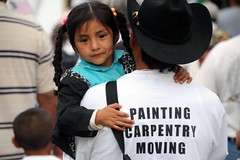 |
On April 17, a few dozen fascists of the American Nazi Party held a rally at the Los Angeles City Hall. Around 1,500 counter-demonstrators came out to shut them down, making clear that their program of white supremacy and anti-immigrant bigotry would not be tolerated.
Hundreds of police officers came out in riot gear to protect the Nazis’ rally and keep the progressive and socialist forces as far away as possible. Otherwise, the fascist rally would have been driven out of Los Angeles, just as they were driven out of Riverside, Calif. a few months earlier. One chant from the anti-racist side drove the point home: “Cops go home, we’ll handle this alone!”
The openly white supremacist organizations remain a small social and political force. Some might even say that the far-right is so marginal that we should simply ignore them. But this logic underestimates the nature of the threat.
For one, it is notable that the main thrust of the Nazis’ propaganda now revolves around “border security” and anti-immigrant rhetoric. After fading out of existence for a few decades, the Ku Klux Klan was reborn in 1915. It constructed its rebirth as an anti-immigrant movement, while still maintaining its legacy of the most virulent anti-Black racism.
The Klan and their anti-immigrant movement were treated as a legitimate voice in the political discourse in 1915. They had the active and open support of U.S. president Woodrow Wilson, and their message was portrayed favorably in notoriously racist movies like “Birth of a Nation.”
In other words, the Klan used the tools of the mass media to reinvent itself. The Klan would have gone nowhere without the support not only of the U.S. president but of significant sectors of the U.S. corporate and political establishment. That fine line between the ultra-right and the “legitimate”—that is, corporate and politically sponsored right wing—was so easily crossed that the distinction was essentially irrelevant.
In the last few decades, the ruling class has appropriated some of the icons of the civil rights movement and many Black and Latino politicians have ascended to the top levels of the state. Given that, it is unlikely major sectors of the capitalists will now promote organizations with the crude white supremacist programs of the Nazis and the Klan.
But in the context of an economic crisis especially, they have no problem in promoting racism and anti-immigrant bigotry in general. In recent months, anti-immigrant rhetoric has ratcheted up. Conservatives focused their fire on undocumented immigrants in the health care debate, and the Democratic Party dutifully obliged by promising not to give health care to this sector of the population.
The “Tea Party” movement, which is nearly all-white and appears to draw primarily from upper-middle class sectors, is driving the Republican Party even further to the right. It opportunistically combines anti-bank and anti-government rhetoric with frequent denunciations of undocumented immigrants, and uses savvy “color-blind” language to disguise its fascistic and white supremacist elements. Even when their events were small, this movement was heavily promoted throughout the corporate media, and given a very light treatment by its so-called “liberal” sectors.
Legislation recently passed in Arizona gives local police officers the ability to ask people of their immigration status as long as they have “reasonable suspicion” they may be “illegal.” This is essentially a prescription for widespread racist profiling against the Latino population. The fascist sheriff of Phoenix, Joe Arpaio, was often called a “rogue” and “renegade” in the corporate press for these very same anti-immigrant tactics. Now the state’s ruling class is making his tactics the rule, instead of the exception.
This May 1, International Worker’s Day, marks the fourth anniversary of the historic nationwide immigrant workers’ strike. On that day, millions upon millions of immigrant workers—documented and undocumented—flooded the streets with their supporters in small towns and large cities demanding respect for all workers.
These demonstrations constituted the largest collective protest in the country’s history. They stopped a particularly odious piece of anti-immigrant legislation—the “Sensenbrenner” bill—in its tracks.
That is the type of movement we need to revive. But in the process, we must learn from the lessons of 2006. Last time, the terrified ruling class jumped into action, devising policies aimed at both pacifying the multitudes and protecting corporate profits. But Congress failed to pass any legislation, and protesters were told that a sweeping reform was impossible without a Democratic majority in Congress. The demonstrations subsided.
Nearly four years of Democratic control of Congress, and one year of Democratic control of the White House have provided not one iota of change for the country’s 12 million undocumented workers. The daily abuse of immigrant workers has only intensified and the shameful raids have only become more frequent.
It is more important than ever that progressives and revolutionaries go out into the streets to expose the myths surrounding immigration and explain its root causes. In the process, a real political education can be given to those who have been innocently duped by the anti-immigrant propaganda of the right-wing and the media. For the most stubborn racists like the Nazi Party, a more forceful, sudden and salutary education will be needed.





